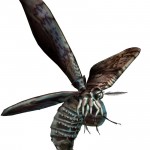Like every other genre, horror can be based in cultural roots and societal norms; as a modern, industrial country, the United States has its own themes—ranging anywhere from office romance to racial tensions in the streets. As a result, it is this very industrial situation that disconnects us so much from the mythology of the past and yet enhances the fears of a world beyond a forest. In this case, I am specifically thinking of insects. Indeed, there are a whole slew of horror films dedicated to these creatures: Arachnophobia, The Fly, Mimic, and Them! to name a few. Being an avid horror gamer, however, I wanted to focus on a specific game, namely Resident Evil.
Now for those not so up-to-date on their gaming, RE narrates the events following a viral outbreak with devastating effects across many species. The series has become iconic for its mesmerizing story, seeming scientific realism, and grotesque imagery.
- Atlas Moth
- Resident Evil Giant Moth
As I mentioned, the RE series actually tends to seem quite realistic and provides the player with several of the researchers’ notes. For the giant moth on the right side, the following was recorded,
“The research into moth-based B.O.W.s was a failure in this experiment. Mutating it to a larger size did not keep them in proportion, making their wings strong only enough to hover over the ground. However they did also develop the ability to spit poison on prey as a means of compensating for their flight problems.”
The moth they seem to have based the design off of was most likely the Gypsy moth. Now, after playing these games for a countless number of hours, I had to wonder exactly why a moth would ever be chosen as a specimen. Belonging to the order Lepidoptera, all moths tend to share key traits that unite them. Some of these relevant traits include:
1. All moths undergo complete metamorphosis where the young experience serious physiological changes towards the adult stage.
2. Most moths have a tubular food canal called a proboscis used for siphoning nectar from a plant.
3. Most moths are omnivorous or phytophagous.
4. Moths also tend to avoid human interaction as you can see from this “little” guy below.
With that said, I can resubmit the question, “Why moths?”
Consequentially, the type of moth used in the game was a gypsy moth or Lymantria dispar. Gypsy moths have actually plagued the U.S. since their accidental introduction in 1868 and more than a hundred years later continue to be widespread pests with sizeable damage to the environment. Although most do siphon nectar, some moths actually do eat away at foliage. Because of their quick generation times and dispersal through flight, moths tend to be quite difficult to extinguish. So, if the idea to use an omnivorous pest as a weapon wasn’t bad enough, you can throw in the idiotic notion of making this American-specific, uncontrollable pest larger! With their drab and foreign appearance, it is easy to understand why, compared to butterflies, they would be chosen as nightmarish creatures for scientific experimentation, but in all honesty, these moths seem to be as deadly as a puppy fighting a lion.
http://www.fs.fed.us/ne/morgantown/4557/gmoth/
http://www.cals.ncsu.edu/course/ent425/library/compendium/lepidoptera.html
http://www.ucmp.berkeley.edu/arthropoda/uniramia/lepidoptera.html


